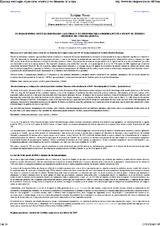El paisaje rural según el parcelario catastral y sus Memorias de la riqueza rústica de 1899. El término municipal de Córdoba (España)
The rural landscape according to the cadastral parcellary and their Memories of the wealth rustic of 1899. The municipality of Córdoba - Spain

Ver/
Autor
Torres-Márquez, Martín
Editor
Universitat de BarcelonaFecha
2012Materia
CatastroPaisaje rural
Cultivos
Córdoba (España)
Cadaster
Rural landscape
Crops
Land uses
METS:
Mostrar el registro METSPREMIS:
Mostrar el registro PREMISMetadatos
Mostrar el registro completo del ítemResumen
Uno de los documentos catastrales que constituye un hito relevante en el desarrollo del sistema administrativo y fiscal para el conocimiento de la riqueza imponible española es el Catastro de 1899. En cierto modo, la elaboración de estas pesquisas catastrales es uno de los síntomas de modernidad que caracterizó al panorama político, administrativo, social y económico del siglo XIX, en post de un estado más funcional y alejado de principios históricos caducos. Su propósito fue alcanzar un sistema analítico de la riqueza rural del país, eficaz y funcional que tasara con objetividad la valía de la riqueza territorial. Esta inquietud culminaría, como resulta bien conocido, con la promulgación de la Ley de 27 de marzo de 1900, impulsada por el ministro conservador Fernández Villaverde. En ella se mejoran algunas disposiciones anteriores y se consigue un paso de gigante en el diseño de un registro catastral de cultivos que tuviera como base los trabajos topográficos y agronómicos llevados a cabo por técnicos independientes del Ministerio de Hacienda, a lo que se unió la elaboración de un registro fiscal de predios rústicos y ganadería que debían permitir un mejor conocimiento de las auténticas bases tributarias de la agricultura. Son tales labores y averiguaciones topográficas y económicas las que permiten, utilizando la cartografía catastral conservada y los cuadernos agronómicos, ofrecer en este artículo una reconstrucción del paisaje rural de los más de 1.200 Km2 que constituyen el actual municipio andaluz de Córdoba, capital de la provincia homónima. One of the land registry documents which is a milestone relevant in the development of the administrative system and prosecutor for the knowledge of the wealth spanish tax is the Land of 1899. In a way, the development of these cadastral enquiries is one of the symptoms of modernity that characterized the political landscape, administrative, social and economic of the nineteenth century, in post of a state more functional and away from historic principles obsolete. Its purpose was to reach an analytical system of wealth rural of the country, effective and functional that valued with objectivity the worth of wealth territorial. This concern culminate, as is well known, with the enactment of the Law on March 27, 1900, driven by the minister conservative Fernández Villaverde. It will improve certain earlier provisions and get a giant step forward in the design of a land registry of crops to take the basis of the work topographic and agronomic carried out by independent technical of the Ministry of Finance, to which he joined the elaboration of a register prosecutor of land rustic and livestock that should allow a better understanding of the genuine tax bases of agriculture. Are such work and inquiries topographical and economic allow, using the cadastral mapping preserved and notebooks agronomic, offer in this article a reconstruction of rural landscape of the more than 1,200 square kilometers that constitute the current municipality andaluz de Córdoba, capital of the homonimous Province.
